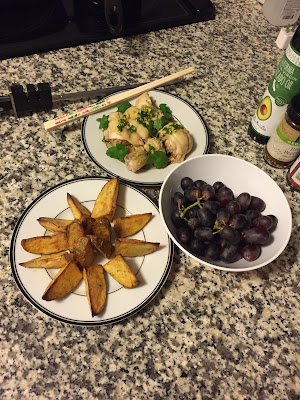I blame the three day lag on this post on nua aura - online gaming with good buddies is a very, very compelling activity to do.
Anyway, enough nonsense, straight to the works -
Day 0: Fixed Assets
The advice you usually get on blogs and books about learning to cook is to invest in a few choice pieces of good, if a little pricey equipment. I call bullshit - at a beginner level of proficiency, there is almost certainly no way that I would be able to tell the difference between chopping vegetables with a $200 knife on a $50 wooden board versus using a cheap but functional $50 chef's knife on a $10 plastic board. By the time I build up an intermediate skillset (~half a year?), reasonably cheap shit would still suffice and would help me identify specifically the limits of skill as opposed to limits of equipment (assuming I wasn't so cheap I bought something that had to be retired by then). When I finally have to retire my first set of cheap shit (~3 years?), if I've been consistent, that is where it may make more sense to invest in the middle of the range.
So with that said, when I went shopping, price efficiency was definitely a top consideration. But before I go down the shopping list, one thing has to be said:
Thank you Mo and Merry - you guys rock.
As you'll see in the tracking sheet, twice as much of my fixed asset inventory was inherited off the goodwill from the two of you sending me shit and passing down stuff to me. For the purposes of understanding the economics of my processes, I had to assign arbitrary values to the items you guys gave me, but the gratitude I have for your thoughtfulness cannot be priced.
In total, with the $200 (post sales-tax) I spent and inherited item, my kitchen is stocked with the following items:
- Steak Knives
- Kitchen Shears
- Knife Sharpener
- Food Tongs
- Cast Iron Skillet
- 7.5" Strainer
- Ramekin 6oz
- Ramekin 10oz
- Ramekin 6oz - Flat
- Ziploc Container
- Small Containers
- Gallon Storage Container
- Roasting Pan
- Dish cloth
- Utensils
- Pots & Pan Set
- Chopping Board
- Salad Bowl - 2 piece
- Chef's Knife
- Steamer
- Plates
- Spatula Set
- Glassware
The first important question we must address is how we value the cooking surface in my apartment. One way to think about would be to find a comparable set of equipment and use the cost of that as reference. However, that is also not entirely realistic, since the apartment has been here for a while and it's more like a second hand stove, if nothing else. The other way to think about it would be to charge the use of the stove as a periodic operating lease. This is closer to reality, since the cost of the stove is very likely one at least an implicit components in the underlying pricing model for this apartment.
The first way seemed easier to me to work with rather than trying to source a reliable estimate for the leasing cost of stove equipment and so for the sake of laziness, we'll run with that approach. If we think about it that way, then we can also assume that we would depreciate a new stove on a straight line basis over ~10 years. So since it's been ~5 years since the last major renovation of the apartment (according to management, I didn't bother to confirm the veracity of that statement), I ran with it and assumed that I had inherited the equipment at a carrying value of half what could be found on a quick Google search.
Immediately, we see one of the key lessons of microeconomics in action here: high fixed costs result in meaningful economies of scale.
One thing to note here is that at 2100 meals (~35 meals per month for 5 years), the per meal cost of the stove equipment is ~$0.40, while at 1200 meals (~20 meals per month for 5 years) it's more than 50% higher, at ~$0.65. That suggests I would value the use of the stove at $14/month and $13/month, respectively, or significantly less than 1% of my rent. What this suggests to me is that landlords should invest in better stove tops in rental apartments, for fuck's sake, at least in the Chicago River North. The economics here suggests that it is very unlikely to affect returns for property management companies, while on the other hand, I hypothesize that for people who do cook regularly, a high quality stove top/well designed kitchen area may be valued at much higher than $15 a month.
Next, onto the food!
Cheers,
Hanchen















